Amazing Bagel Bread {Step-by-Step}
I never knew I wanted all the deliciousness of a classic, chewy bagel in bread form until now! This amazing bagel bread is life changing! {Step by step pictures below in the post.}
Do I ever have the most delicious weekend baking project for you ever. EVER!
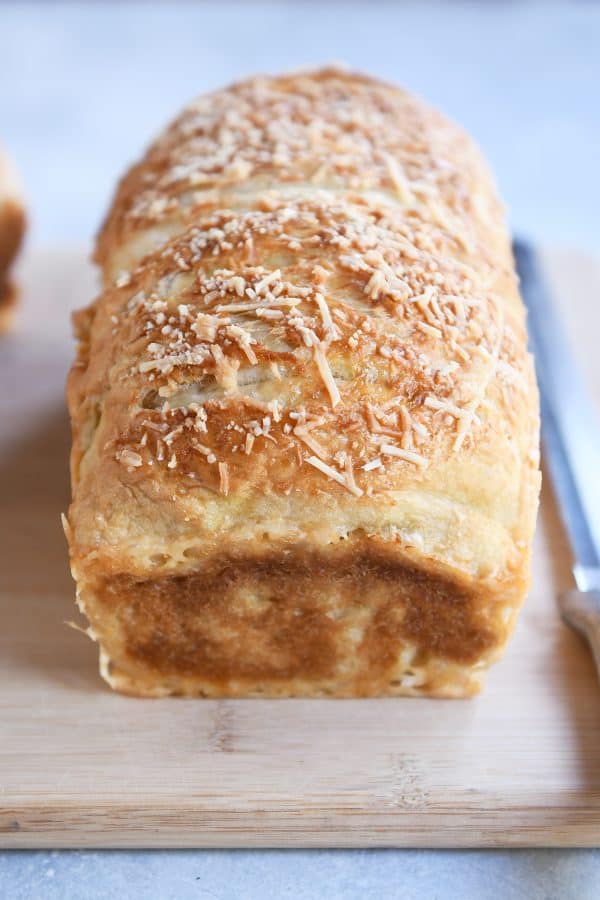
It took a few more times of making and testing the bread + bribing my 14-year old to help me take step-by-step pictures (it’s shockingly hard to flip a loaf of bread into boiling water with one hand whilst snapping photos with the other).
But it’s finally here. And it is worth the wait. Plus, my teenager did not complain about his payment for picture taking being a whole loaf of this bread to himself. He did not share. I did not blame him.
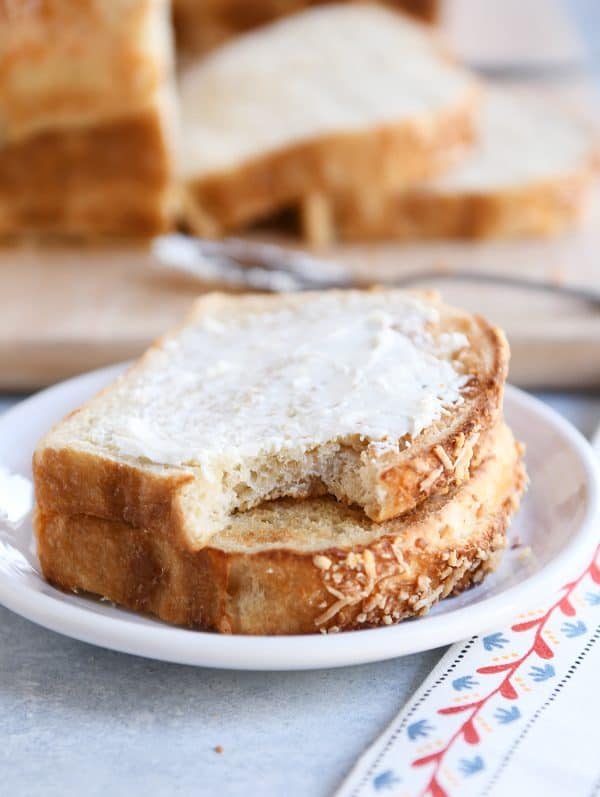
This bread has all the delight of a classic, chewy bagel tucked into a cute little loaf!
If my family is any judge of how good this bread is (i.e. can polish off two loaves in a day), I think you are going to love it. Delicious toasted, delicious untoasted. Fantastic with cream cheese, fantastic without.
Honestly, this is the bread dreams are made of. It is so, so good. Hard to resist, actually, and it will most likely be my ultimate carbohydrate undoing.
We are partial to Parmesan and Asiago bagels around here. All six of us prefer that variety, except for Brian who is the odd man out and goes for the cinnamon raisin or blueberry bagels (insert us all giving him the side eye). I mean, no judging…kind of.
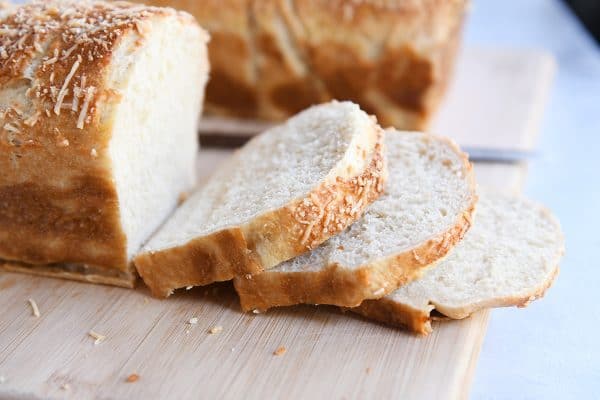
But rest assured that even though this recipe and tutorial is for cheesy bagel bread, you could alter and adapt that topping to your heart’s content.
Because this bread has a few unique steps, I want to walk through the step-by-step tutorial with you.
Feel free to ask any additional questions in the comments! This bagel bread may look and seem intimidating, but I promise the effort is worth it (and it’s actually kind of hard to mess up, trust me).
Start mixing up the dough in a stand mixer fitted with the dough hook. I use a Bosch mixer {aff. link} for 99% of my bread making, but this amount of dough *should* fare pretty well in a KitchenAid or other smaller stand mixer.
Usually I have the plastic ring-lid on the Bosch as well for mixing, but for better picture taking, I left it off for these pictures.
This dough is pretty straightforward: mix the water, honey, yeast, salt and a couple cups of flour together and then continue adding flour gradually while the mixer runs on low speed.
The recipe calls for bread flour, but you can use all-purpose flour + gluten for a bread flour sub (see the notes of the recipe below).
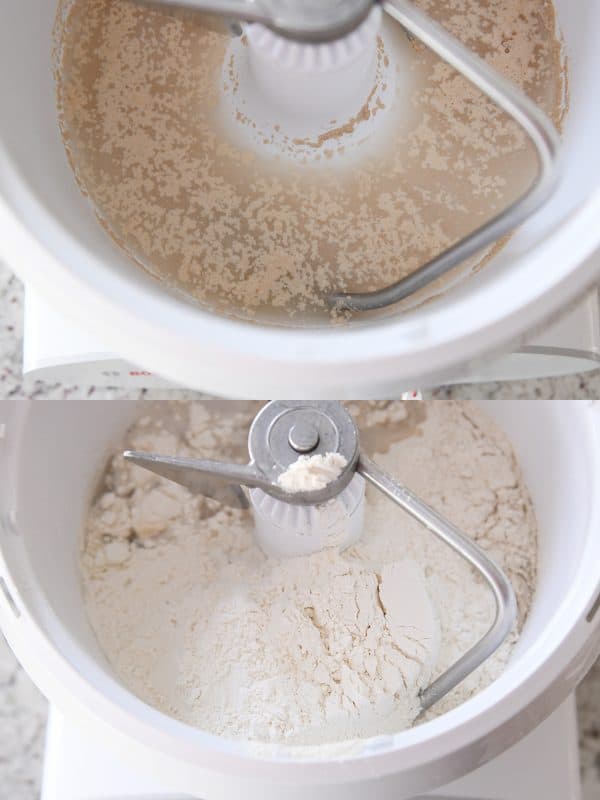
The dough is going to look shaggy and messy as it starts mixing but gradually it will form a smooth ball and clear the sides of the bowl. Resist the urge to add excess flour!
Only add additional flour if the dough is leaving a lot of sticky residue on your fingers and won’t come together in a soft, smooth ball.
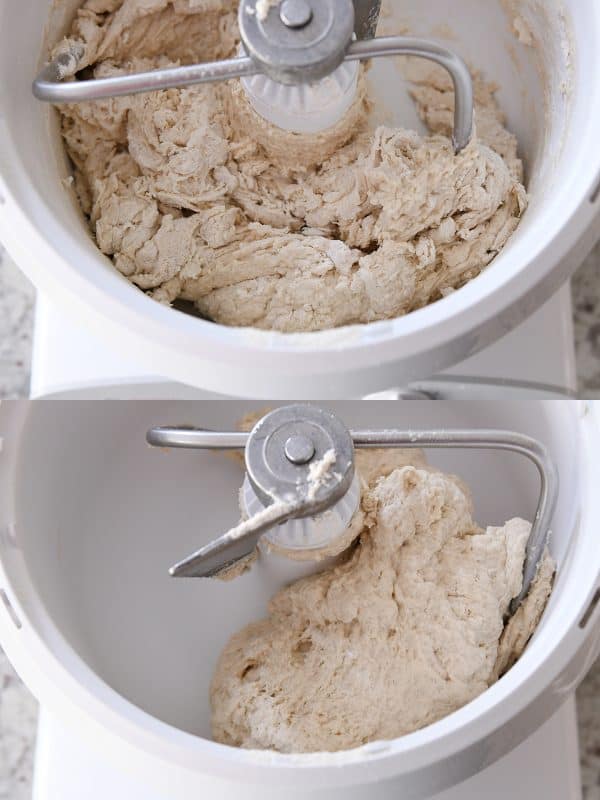
There we go. Bagel dough perfection.
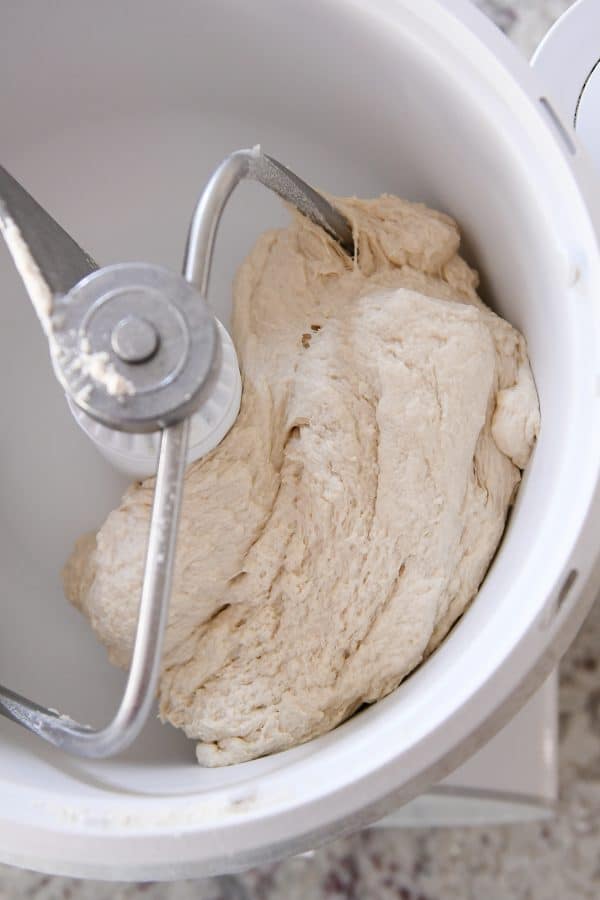
Now, cover the mixer with a clean kitchen towel and let the dough rest for 10-15 minutes. This is going to help relax the gluten and get the dough ready to be shaped into loaves.
I use flour sack kitchen towels for most of my dough rising ventures these days. The towel in these pictures was hand-embroidered for me by my talented cousin, Alex, for my birthday a few years back, but I also have tons of these thin, white towels {aff. link} and use them constantly in my kitchen.
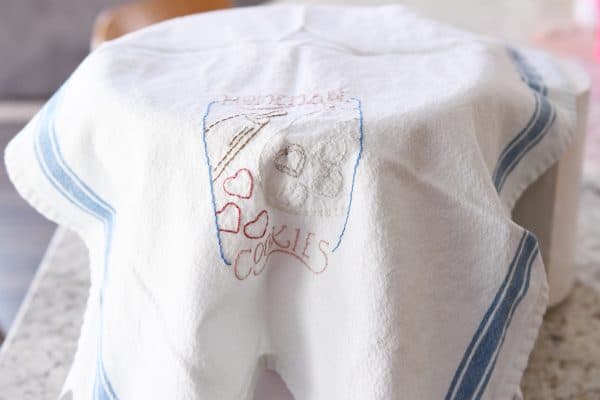
After the dough rests, turn it out onto a lightly greased or floured counter and split into two equal halves. You can be a nerd like me and use a kitchen scale, or you can just eyeball it.
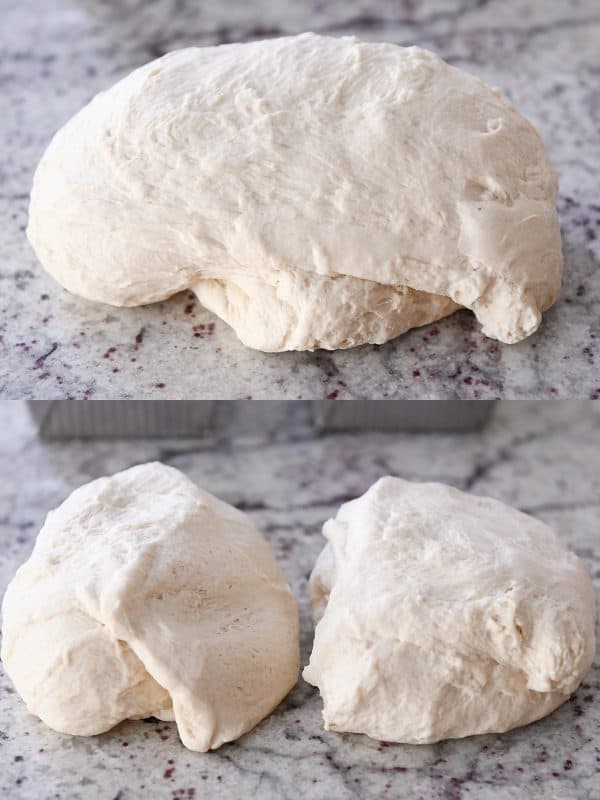
Press each half into a really thick oval. Or blob. However you’d like to refer to it is fine. This part is definitely not rocket science.
Take the lower edge and fold it up toward the middle.
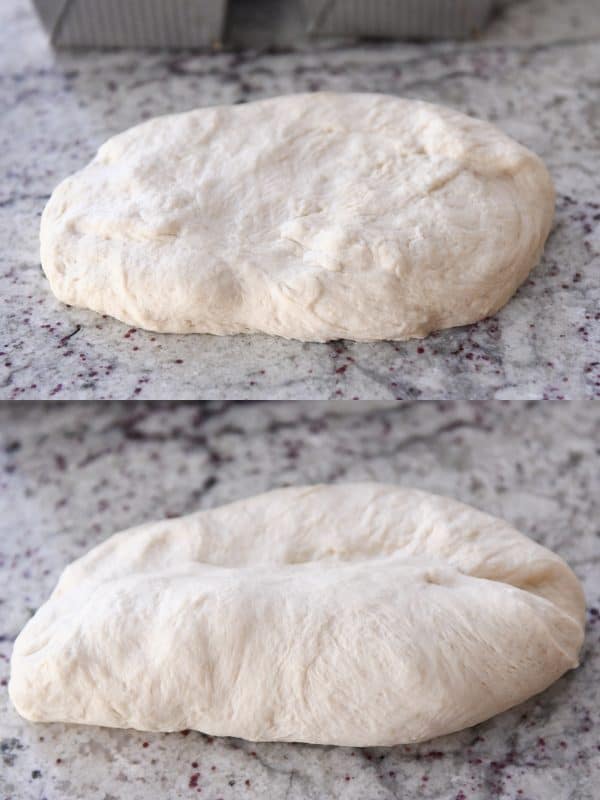
Then grab the top edge and fold it down a little past that middle seam and pinch it closed.Flip the dough over seam side down and give it a good pat and a gentle roll to smooth out the edges, especially the two short ends.
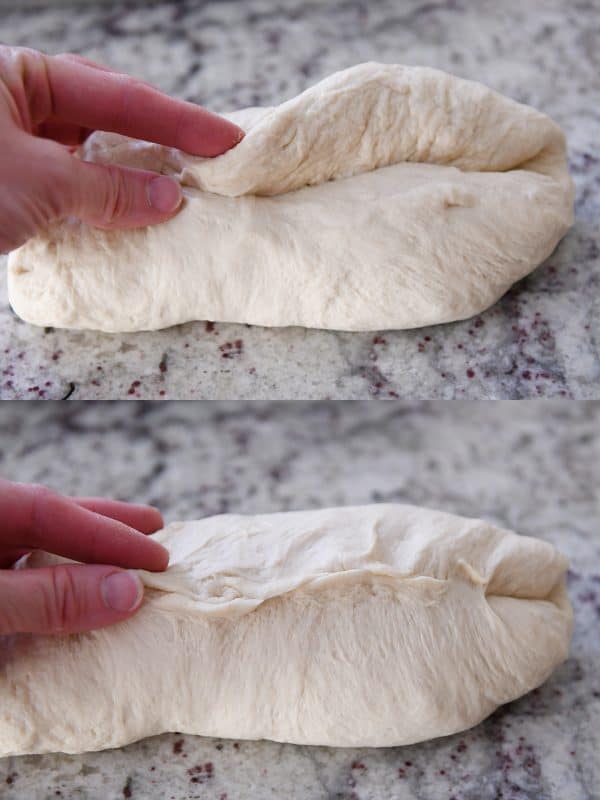
Place the loaves in lightly greased 8 1/2-by-4 1/2-inch baking pans. These USA bread pans {aff. link} are my all-time faves with the long-standing Chicago Metallic pans {aff. link} a close second.
I have not tested this recipe with glass or ceramic loaf pans.
Cover the loaves with a clean kitchen towel or greased plastic wrap and let them rise for about 45 minutes to an hour until the dough is noticeably puffy and has risen just above the edge of the pans.
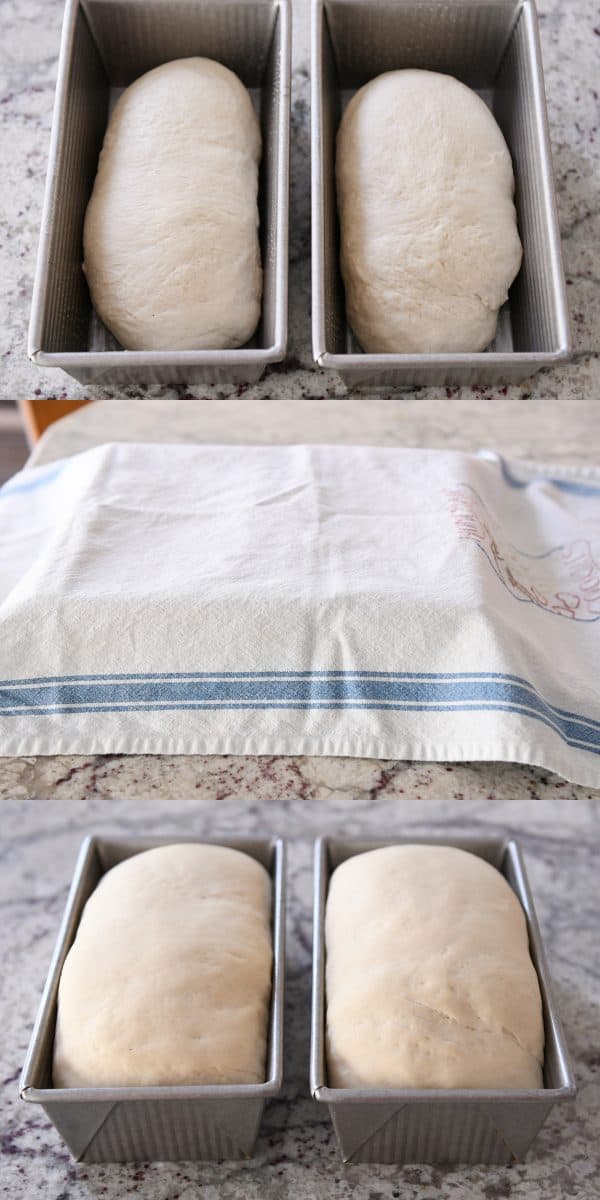
Toward the end of the bread’s rising time, start a large pot of water boiling. You’ll want about 4 quarts of water…and the pot should be about 10 inches wide at least to fit the loaf of dough (it will expand a bit as it cooks in the water).
Once the water is boiling add the honey and baking soda and stir to dissolve.
Now, here’s the part that I understand may cause some of you a bit of stress. You’re going to do something that you’ve probably been told to never do in the history of ever! You are going to seriously mess with a perfectly risen loaf of bread and turn it out of the pan into your hand (to be placed into the boiling water).
Take a deep breath. You’ve got this.
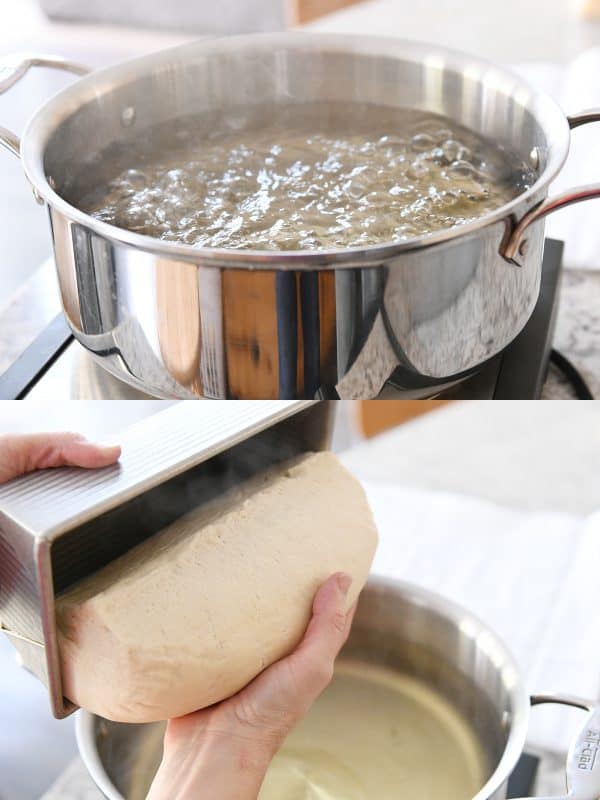
The loaf of bread is going to deflate (although try to be as careful as possible to minimize this deflation). It’s going to look misshapen and messy. And I know this is going to impact some of your stress levels in an elevating way.
But I promise that even if your bread dough looks like this (below!), if you can hang tight for just a bit longer and trust me with your dough, everything will work out in the end.
It’s kind of a miracle really.
So go ahead and place that loaf of bread dough in the boiling water and let it simmer away for about 60 seconds. Then, with a wide, flat spatula or other kitchen implement, flip the bread dough and cook it for another 45-60 seconds on the other side.
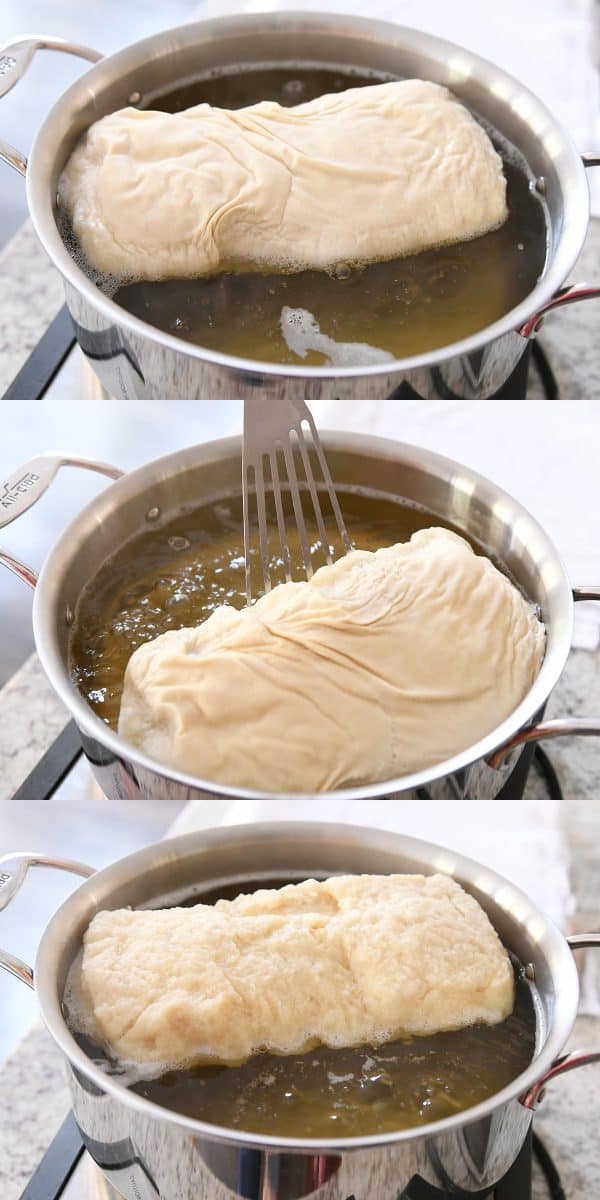
Now take a deep breath, and using all the wits and aptitude and coping skills you have, grab whatever spatulas or spoons or wide tools you have to hoist that loaf of bread out of the boiling water and onto a clean kitchen towel.
Alert! Don’t use paper towels. You’ll cry big, sad, fat tears when your dough is stuck horribly and irreparably to the paper towels. Use part of the towel to gently and quickly dab at the dough to get rid of excess water. The soft sticky dough is probably going to stick a bit to the towel and leave some dough residue there, but it shouldn’t be excessive and my towels washed up just fine (it helps to let any dough reside dry completely on the towel and then pick/flick it off before washing).
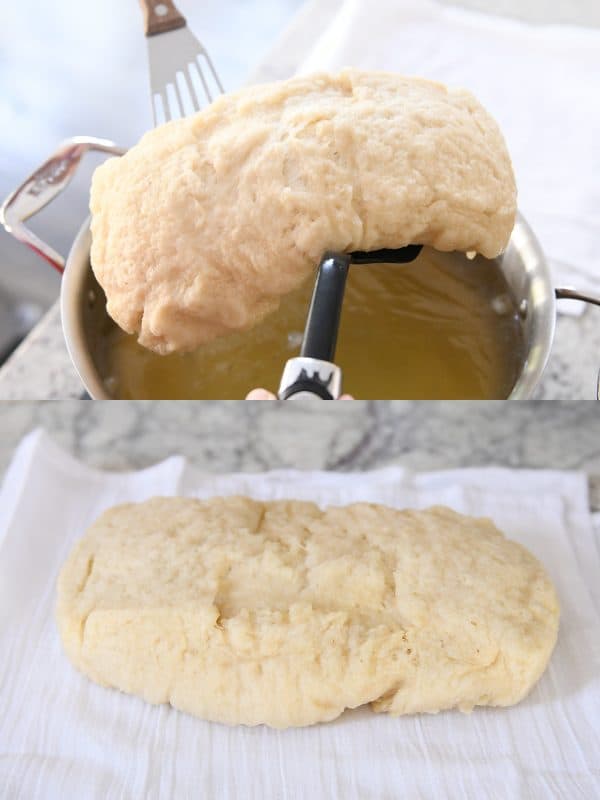
It’s not going to go into the pan perfectly. The dough is really sticky at this point and it may look kind of a mess. If you are wondering right now at this point how something so hideous looking will ever bake into the most glorious loaf of bagel bread ever, you are not alone.
I feel ya. I thought the same thing. But after making this bread a dozen times over the last several weeks, I can assure you, my little chick, all will be well.
Tuck the dough evenly into the pan.
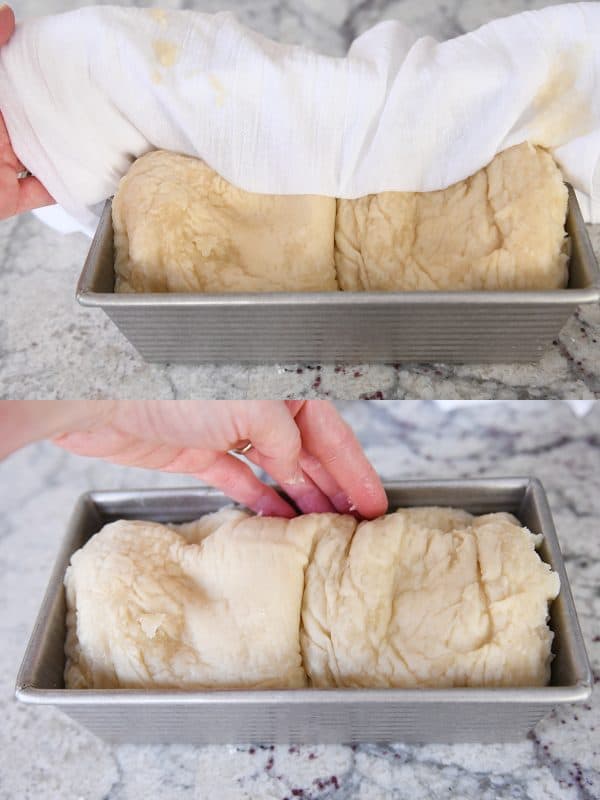
Go ahead and repeat that process with the second loaf. The first loaf can hang out and wait a few minutes.Take a sharp paring or serrated knife (this inexpensive knife, aff. link, is my fave and works perfectly for this) and cut slashes crosswise across the top of the loaf. This is not the time to get all your boiling bagel bread aggressions out on the bread. Don’t go slashing inches deep. A quarter inch will do just fine.
Then brush the top of the bread with a lightly beaten egg.
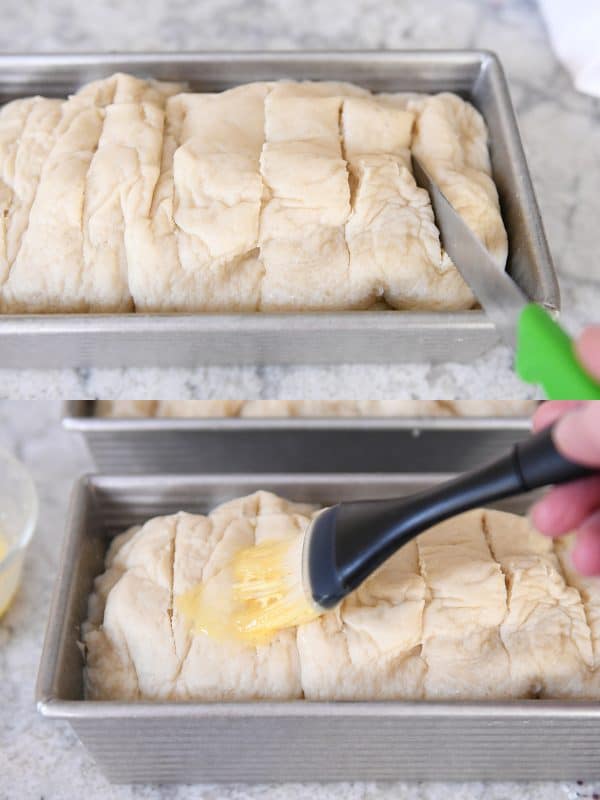
Sprinkle a little (ok, a lot!) more cheese on top and immediately pop that bread into a 350 degree preheated oven (no need to let it rise!).
In about 40-45 minutes you are going to have some of the most glorious bagel bread coming out of your oven, and I swear, you might even hear the faint but distinct notes of angels singing somewhere.
Let the bread rest in the pan for 15 minutes or so before turning out onto a cooling rack to cool completely.
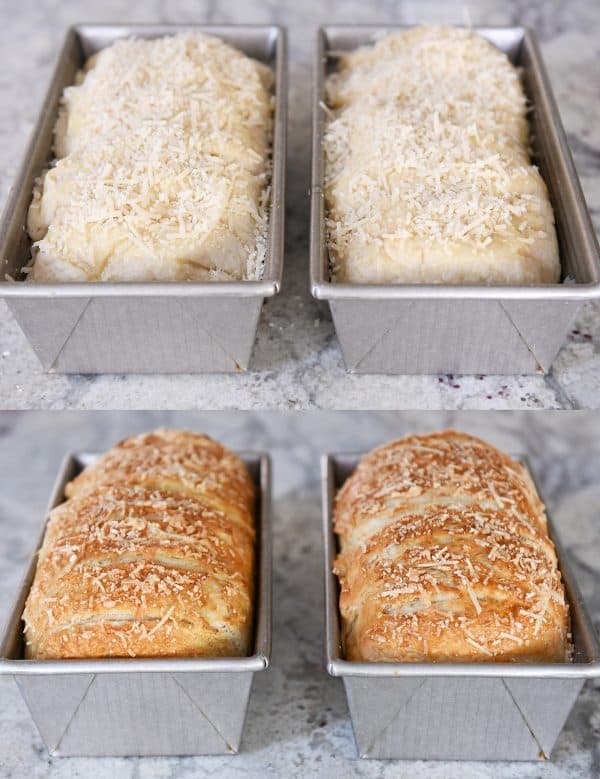
While you may be tempted to cut right in, the texture and flavor of the bread is better once it has cooled.
But after that, go crazy. Seriously, don’t even try to hold yourself back.
This bagel bread is ridiculously yummy sliced and toasted and slathered with cream cheese or butter. But it is equally tasty untoasted – chewy and soft and absolutely perfect.
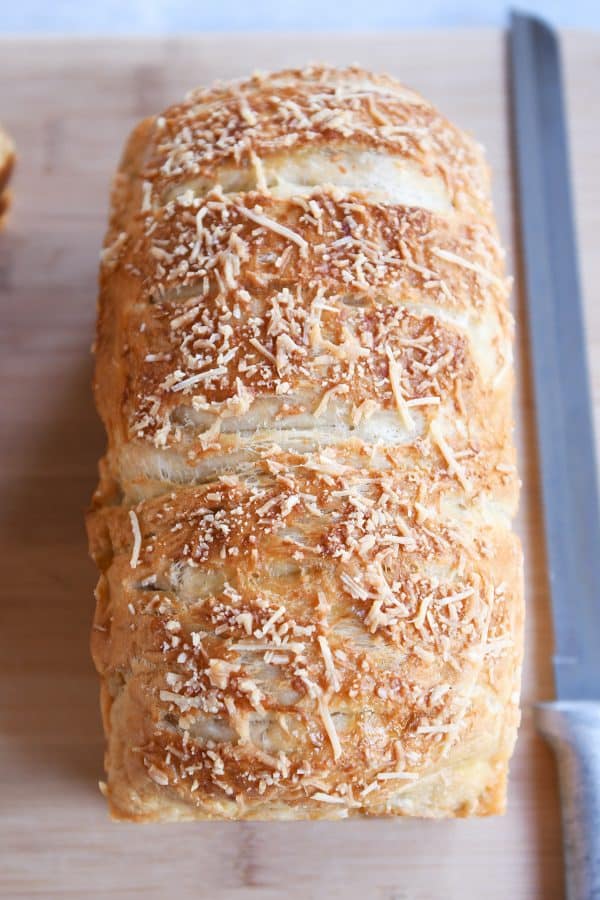
I know this bagel bread may not be your average everyday baking project, but I hope you try it! There’s something so rewarding about combining the ever-simple ingredients for bread and watching how they transform into a loaf of golden deliciousness.In this case, bagel bread may have surpassed all the other bread loves in my life. We can’t get enough.
The baked loaves freeze great, but it also keeps well for several days (especially if using as toast).
Bagel bread! Who knew! Hope you love it as much as we do.
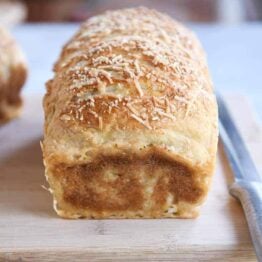
Amazing Bagel Bread
Ingredients
Bread:
- 2 ½ cups warm water
- 4 tablespoons honey
- 1 ½ tablespoons instant or rapid-rise yeast, see note for active dry yeast
- 1 ½ tablespoons coarse, kosher salt (use less for table salt)
- 5 to 5 ½ cups (709 to 780 g) bread flour (see note for substitutions and notes about exact flour amount)
Topping:
- 1 egg, lightly beaten
- ½ cup (57 g) freshly grated Parmesan or Asiago cheese, or other toppings of choice, like sesame seeds, poppy seeds, Trader Joe’s everything but the bagel seasoning, etc
Water Bath:
- 4 quarts water
- ¼ cup (85 g) honey
- 1 tablespoon baking soda
Instructions
- For the bread, in the bowl of a stand mixer fitted with the dough hook, combine the water, honey, yeast, salt and 2 cups of the flour. Mix until combined. With the mixer on low speed, continue adding flour until the dough comes together and clears the sides of the bowl. The exact amount of flour doesn’t matter as much as the texture and feel of the dough. It should form a soft, smooth ball that is still a little tacky to the touch but doesn’t leave a lot of dough residue on your fingers. Knead the dough for 5 minutes.
- Cover the mixing bowl and let the dough rest for 10-15 minutes.
- Turn the dough out onto a lightly greased or floured counter and separate into two pieces.
- Shape each piece into a loaf by pressing into a thick rectangle, folding the bottom edge up to the middle and then grabbing the top edge and folding it down over the dough and pinching the seam to seal. Turn the loaf seam side down and pat and roll lightly to form an even 8-inch loaf.
- Grease two 8 1/2-X-4 1/2-inch loaf pans. Place the loaves seam side down in the prepared pans. Cover with a clean kitchen towel or greased plastic wrap and let rise in a warm, draft-free spot until the dough rises just over the edge of the pan, about 45 minutes to an hour.
- Toward the end of rising, prepare the water bath by bringing the water to a boil in a pot (that is at least 10-inches wide). Add the honey and baking soda and stir to dissolve. Also, fold a clean kitchen towel (like a thin flour sack towel without any texture or terry cloth fabric) in half and place next to the stove.
- Preheat the oven to 350 degrees F.
- One at a time, carefully turn the loaf of risen dough out into your hand and place the loaf into the boiling water. It’s ok if the bread loaf deflates and looks a bit wonky. It will all work out! Promise. Cook for 1 minute and then use a wide flat spatula or other tool/spoon to flip the dough and cook for another 45 seconds to 1 minute.
- Using a couple of wide spatulas, carefully transfer the loaf and place it on the folded towel, using extra towel length to quickly pat any water off the top and sides of the dough.
- Spray the same loaf pan with cooking spray and sprinkle a couple tablespoons of cheese evenly across the bottom of the pan. Transfer the dough (that’s been boiled) to the pan (using the towel to help transfer the hot loaf, if needed), tucking the dough down around the edges into the pan in an even shape.
- Repeat the boiling process with the other loaf of dough.
- With a sharp paring or serrated knife, cut five or six slashes about 1/4-inch deep crosswise on the top of each loaf of dough. Brush the top of with the beaten egg and sprinkle each loaf with a couple more tablespoons of cheese.
- Bake the bread in the preheated oven for 40-45 minutes until golden on top (an instant-read thermometer should read 200 degrees at the center of the loaf).
- Let the bread cool for 15-20 minutes in the pan before turning onto a cooling rack to cool completely. Slice, toast, slather with cream cheese, devour!
Notes
Recommended Products
Recipe Source: inspired by a recipe in Oct/Nov Cook’s Country (I adapted and changed recipe for two loaves, used honey instead of corn syrup, changed the topping from seeds to cheese, etc)

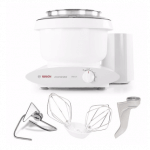
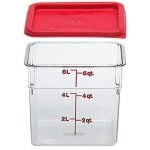
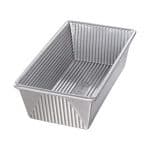

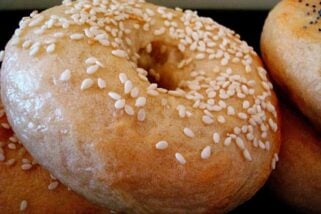
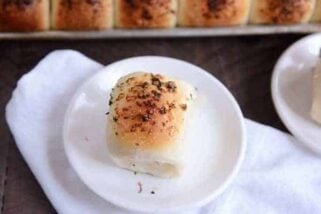
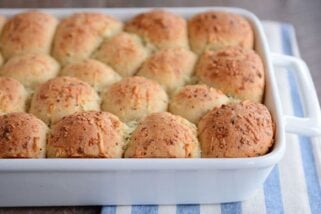
Whoa. This is incredible. Another fan favorite in this household. Next, I’m going to try the cheddar/jalepeno version that someone kindly suggested. Thanks again, Mel.
Also, I used one glass pan and one dark metal pan and both loaves turned out great. I used the thermometer like you suggested and, not surprisingly, the loaf baked in the dark metal pan was done first.
So – I LOVE this bread! I have made it and gifted it to EVERYone in the last couple of weeks since I found it. It’s so easy. Last week I made a cinnamon/brown sugar swirl in it. One of the loaves split apart – and was very hard to get out of the boiling water…. but I went with it and said a little prayer. It came out fine! YUM! Just a pain! Thanks for the recipe Mel! LOVE IT! Gonna try the sourdough loaf in the comments this weekend! That would make it a step better – but LONGER. Hope I can wait! xoxox
I hope the sourdough version worked out well for you, Pam! I have been wanting to try it that way, too! Also, made me smile that you “said a little prayer” – glad I’m not the only one who prays over the outcome of my baked goods! 🙂
So delicious! The first time I made it, flipping the bread in the water was a disaster. But I have made it 4 times since then and it has become a lot easier! Totally worth it!
I use Everything Bagel seasoning and grated Parmesan.
Simply amazing! I was so nervous to make it but first attempt turned out great! Will make it again and again.
This is super yummy and cheesy! Totally try it out!
I made this tonight with the creamy tomato pasta soup and wow. I used all purpose flour and did not add gluten because I don’t keep that on hand either. Aside from that I used my ceramic loaf pans and these loaves cooked up absolutely perfect at 45 min. The water bath was glorious, that’s one step I’ve never done. The bread was an absolute hit among all my kids big and small. Delicious!! I’m guessing bread flour would have densed it up more like bagels but I don’t buy it and all purpose alone was perfect. I did use 7 cups though. I don’t pack my flour though. Just skim off the top so maybe that’s what I needed more. Loved this so much! And it paired amazingly with Mel’s creamy tomato pasta soup! Wow!
This is amazing!! Thank you!!! I’m even going to make some for friends!!!
May I ask the point of the folding? Could you not just shape it to fit in loaf pan?
As long as the loaf is tightly formed, it’s fine however you shape it.
I made four mini loaves out of this recipe (pan size is 5.25 x 3 x 2.25). Worked out great! It took about 10 minutes less time to rise and to cook than the recipe called for. Also, I would suggest double the cheese amount noted.
I love this bread❤️ How long can you keep in a bread container since it has cheese on it. Does it have to be refrigerated since it has cheese. I want to make it again but I’m concerned how to keep it and how long. Please let me know
Hi Jane, I store it at cool room temperature for 1-2 days (sealed in a bag). You can refrigerate, as well, if you are concerned about the cheese.
I am single – can I make these into mini loaves?
I bet you could! Should work out just fine.
Have you run into anyone yet who has baked these in glass or ceramic loaf pans? I have both of those but no metal. I don’t want to waste the ingredients and time to experiment but I also don’t want to make the investment in more loaf pans if they’re not necessary. I’m anxious to try this – I haven’t been brave enough to try making bagels yet!
Hi Avra, two people just tagged me on Instagram and both made them in glass pans with beautiful results!
Thank you!
can I use the dough cycle of my bread maker?
Could definitely try! I don’t have a bread maker so I’m not sure how the quantity would fit – so make sure to double check the size of your bread maker to make sure the amount of dough will fit.
With the water bath, how many recipes of dough do you think I can use in it? I want to make 4-6 loaves for a meeting but I only want to make one water bath. Think I would be good to reuse it through-out the day?
Also, have you ever tried mixing in other ingredients? I want to try maybe a blueberry loaf and a cinnamon chip loaf and was just curious if you had any updates on that process.
I’ve made up to four loaves in the same water bath. The water gets noticeably darker/filmier with each loaf but it doesn’t seem to affect the taste. Any more loaves and you may need to top off the water and let it heat up again. I haven’t tried mixing in other ingredients but I think it should work great!
I did four loaves and you are correct, the water did get darker.
I mixed in a cup of dried blueberries. After the initial kneading, but before resting it for 10 minutes, I folded the dried blueberries and kneaded the dough for just another minute by hand. I let the loaf rest and proceeded as normal. I was worried about dry blueberries robbing moisture, but it worked out beautifully. People asked me if I had used fresh blueberries.
I also did a loaf of cinnamon chip, but I didn’t add the full cup of chips. At about half a cup, the loaf had plenty. My chips were on the miniature side though.
My third loaf was a cheddar jalapeno. I like chunks of cheese (probably 1/4inch cubes), versus a shredded, so it was just under a cup of cheddar.
Thank you for your help and giving me confidence to experiment. Over all your years blogging, just know you’ve given people a ton of confidence.
I love the variation in the loaves you made!! Thanks for including your variations.
My family looooooved this!!!! We loved it best with plain cream cheese spread on it.
So good!!! Definitely adding this to our must make a lot list!!!!!
My bread didn’t rise. Should I have proofed the yeast in the water and honey first? I obviously killed it. Not sure I’ll try again.
Hi Teresa, did you use instant yeast per the recipe or another kind of yeast? Active dry yeast may need to be proofed in water until it bubbles. Also, if your yeast was expired or the water too hot it can contribute to the dough not rising.
Mel, talk to me about your granite countertops. What’s the name of the granite? Has it held up well to stains and scratches?
Hey Emily, the name of our granite is Bianco Romano (or something like that…I can’t remember exactly!). We’ve had it for almost ten years and it’s held up like a dream!
YUM! Absolutely delicious – hot buttered bagel bread on a cold winter afternoon. What a great recipe – thank you!
I made this wonderful bread a while back, and wanted to come and check out your posting again for a refresher lesson before I make it again tomorrow. Thank you so much for all the great photos, they help a lot with this recipe!
What purpose does the honey serve in the boiling water? I only ask because it felt like a bit of a waste of honey. I’m wondering if sugar could be used (less expensive and easier to part with).
You could try sugar – I believe the honey helps the bread brown in the oven.
I would Like to make this for breakfast. Is there a good overnight Option?
I haven’t ever made this overnight – sorry I’m not more help!
I made this yesterday and will definitely make it again. One loaf came out a bit gummy but the other was good. Not sure why.
I needed to add quite bit more flour so maybe I added too much?
Mine too sort of fell apart in the water. I read the other comments and will seal it better next time.
Tasted great though!
This recipe is AMAZING! We tried it last week and have made it several more times since then! Thank you, Mel!
This bread is AMAZING and a lot easier to make than it seems! It’s great with rosemary on the top as well. My roommates and I made a few loaves of this and it was gone pretty fast because it’s just sooo good. I legitimately got my roommate a husband because he claims he wasn’t sure she was interested until we brought his apartment a loaf and they started dating the next week haha!
Mel have you tried using whole wheat flour + vital wheat gluten to make these (or even just part whole wheat flour)?
I haven’t tried 100% whole wheat flour, but I have tried half whole wheat flour and it works great! (I didn’t add any vital wheat gluten).
I just made a giant batch of rosemary focaccia yesterday and yet I find myself wondering if I have any raisins stashed away to make a cinnamon raisin bagel loaf. This seems way easier than making homemade bagels!
Is it possible to use gluten free flour with this bread?
I don’t think so (at least, I haven’t tried it; gluten-free flour behaves very different in bread/gluten recipes like this).
I’ve made this several times with sourdough starter and wanted to share my measurements with others wanting to use their starter. I’ve only done one loaf, so it’s about half of the recipe ingredients in grams. 250g water, 42g honey, 70g fed starter, 10g salt, 365g bread flour ( I use King Arthur). I mix by hand to a shaggy ball, rest for 20-30 min. Then stretch and fold til smooth. Rest 30 min and stretch/ fold one more time. Continue with recipe at step 4. It takes about 5-6 hours to rise to edge of pan ( or almost) depending on how warm your room is. Right now we are about 78-80. I usually refrigerate overnight and boil/ bake the next morning. It really is delicious! Use your best sourdough bread making instincts if things don’t feel right as you’re going along. Hope this works for you.
This is amazing! Thanks for sharing, Kathy!
Hi! I was wondering if the dough was able to be frozen after the shaping, then thawed out, proofed and baked later?
Have you tried this? I wanted to know before I try to make a large amount for an upcoming gathering?
I haven’t tried that, but usually bread doughs like this freeze well. Sounds like it is worth experimenting!
Yup! It freezes great!
Thank you for the recipe. It tastes delicious. I did wonder if anyone else had the same problem I did in that the dough was really wet. What am I doing wrong?
I am surprised I haven’t left a review until now! We found this recipe during COVID. I am an avid bread baker. I make 4-8 and sometimes 12 loaves a week. This is our FAVORITE loaf of bread. Seriously the best. I double this recipe every time. Everyone who tries it says it is the BEST bread. It always looks amazing. The texture is light yet dense and chewy. Absolutely delicious.
I love it toasted with butter or cream cheese. It makes an awesome avocado toast. Or my favorite way is with an egg, smashed avocado, tomato and cheese toasted sandwich!
When I double it, I only use 2 1/2 T of yeast. It works great. I have also found that after I boil the loaves and put them back in their pans and season them on top, then I turn on the oven to 350. That gives the loaves just an extra lift. I have also found that cooking the 4 loaves at 43 minutes is perfect for my oven and my 6,000 ft elevation.
This was so good and relatively easy! I did one loaf with the asiago and another with cinnamon/brown sugar, which I folded in when forming the loaf. Next time I’m going to fold in the asiago too! Awesome toast!
I’ve made this recipe twice and we loved it both times. I definitely added at least an extra cup of flour if not more. Otherwise, we follow the rest of the recipe. So delicious! Thank you for the detailed instructions! It was really helpful!
I made this today and was amazed at how good it is!
I will definitely make it again.
We love this bread in my house! And I use regular APF and about 20% wheat flour and it still turns out great! Thanks for the amazing recipe!
I have made this over a dozen times including baking loaves for Xmas gifts and always a winner. Have made everything bagel bread mostly but also cheese and a raisin pecan bfast loaf. Don’t be afraid to add flour. Every batch I make I use different quantities of flour. Also full minute each side in water bath for chewier crust, more dense bread. A bit less time each side for softer bread.
This is a winner Mel.
Only problems are 1. My husband only eats bagel bread now and 2. Everyone complains no directions for how to stop eating this amazing bread:) thanx
Yes I’m in the process of making bagel bread. Its abit too sticky so I dusted my counter pretty good. Got them in my 2 pans but look really loose, waiting for the rise before water bath what happens if they fall between my fingers before they go in? What did I do wrong?
I couldn’t find my favorite cheese bagels at the grocery store last week so I made this bread yesterday and it turned out perfect! I was skeptical as to whether it was cooked through when I started slicing it but it was just right. Had a toasted, buttered slice with dinner last night, and I enjoyed it for breakfast this morning topped with avocado. Instructions were very help and easy to follow. Thanks for sharing this wonderful recipe! I’ll be making it again!
I’m an experienced baker, especially of yeast breads ( hundreds of loaves of challah, italian, french, pizzaand this was a huge fail for me. I followed the instructions to the letter, with one exception, I did not use the cheese topping. I usually make my own bagels, which are good, but I’ve not, yet, been able to replicate the heft and chewiness of a true bagel, I saw Jennifer Garner make this on her FB live and was intrigued and I was hoping to get something close to a real bagel. The bread was visbly uncooked in spots along the bottom and though the upper portion appeared to be cooked, it was not.I used two instant read thermometers…180 degrees @ 40 minutes, 200 degrees @ 45 minutes. I had been very hopeful as my dough rose very nicely when it first went into the pans. Thanks for the intriguing idea, but I’ll stick to my regular bagel recipe for now.
Sorry to hear this recipe didn’t work out for you!
I just made this (thanks for the recommendation Jennifer Garner!) for my bagel loving kids. It was a HUGE hit with chive cream cheese. It was so good I tried your instapot creamy baked ziti for dinner and my mildly picky eaters loved it so much. Super glad I found your blog!!
Thanks, Olivia! Glad you found your way here!